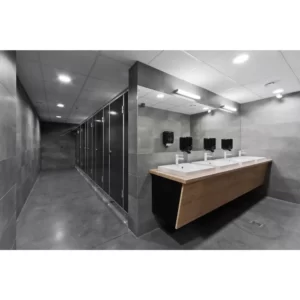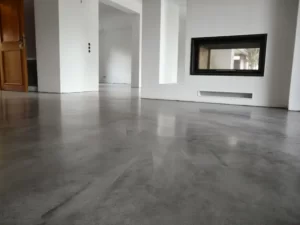Microcement, also known as Microconcrete, is a modern technology in finishes that is used in many important applications and possesses a set of key characteristics that have made it a distinctive and preferred building material in many uses. Therefore, it deserves us to dedicate this article to it.
What is Microcement?
It is a material that consists of a mixture of cement, gravel, polymer, and acrylic resins, used in interior and exterior finishes to cover horizontal and vertical surfaces in houses, commercial buildings, restaurants, hotels, shopping centers, hospitals, offices, and others.
Uses of Microcement

Microcement
Microcement is used in many important applications, such as floors, walls, ceilings, exterior facades, furniture, kitchens, bathrooms, and others, and is characterized by a wide and diverse range of colors, designs, and patterns.
Applications of Microcement:

Microcement
Floor finishes: where it is used in designing interior and exterior floors to give the concrete impression with the possibility of adding colors and decorations to produce unique and distinctive designs.
Wall and ceiling finishes: Microcement is used in designing exterior and interior walls and ceilings of buildings.
Entrance finishes and exterior facades: It is used in various ways in designing entrances and exterior facades of buildings to produce unique designs.
Furniture and exterior decorations: Microcement is also used in designing furniture and exterior decorations.
Advantages of Microcement as a modern technology in finishes
Microcement is characterized by a set of important advantages, including:
– High durability: Microcement is resistant to corrosion and can withstand high pressures.
– Easy application: Microcement is used easily and quickly and applied in various ways.
– Diversity in design: This gives designers flexibility in renewing and innovating.
– Fire resistance: Microcement is characterized by its resistance to fire.
– Moisture resistance: It is used in humid areas and does not require continuous maintenance.
– Environmentally friendly: Microcement is characterized by not causing any pollution and being an environmentally friendly material.
What are the basic steps for using Microcement in designing floors?

Microcement
Using Microcement in designing floors requires basic preparation and application steps, some of which we will review:
Preparation: Proper surface preparation is required before starting to apply Microcement by cleaning the surface from dirt and dust and removing any surface defects or flaws.
Installation: Install a metal mesh or fiberglass strips on the surface of the floor to increase durability and strength using the appropriate adhesive materials.
The first layer of Microcement: The first layer of Microcement is formed after mixing Microcement with water in a specific ratio and applying it to the surface of the floor using appropriate tools.
The second layer of Microcement: After the first layer of Microcement has dried, the second layer is applied to add more thickness and strength to the floor.
Drying: Microcement is left to dry for at least 24 hours, and the surface is covered with plastic sheets to prevent moisture formation.
Polishing and buffing: After Microcement has completely dried, it is polished and buffed using appropriate equipment to obtain a smooth and shiny surface.
Applying Microcement requires special skills and experience, so it is recommended to rely on specialists in this field to get the best results.
If you need free technical advice, you can contact us and communicate with one of the experts at Alio-Mar company to get the help you need.
Using Microcement in designing entrances and external facades has several advantages that make it suitable for this purpose, such as:
– Durability and hardness: Microcement is known for its hardness and durability, making it suitable for use in entrances and external facades that are exposed to high loads and various weather conditions.
– Elegant design: It can be used in entrances and external facades in a wide range of shapes and colors.
– Fire resistance: It is a safe material to use in entrances and external facades.
– Easy maintenance: It does not require continuous maintenance, and it is resistant to dust, dirt, and moisture.
– Environmentally friendly: It complies with environmental standards and contributes to environmental conservation.
Using Microcement in designing entrances and external facades requires some basic considerations and steps, such as proper design, surface preparation, choosing the right adhesive material, and proper application. It is essential to rely on specialists, such as Alio-Mar company, to get the best results.
Some important points to consider when using Microcement in entrances and external facades include:
– Design the entrance or facade to match the architectural style of the building to achieve the desired aesthetic.
– Determine the required thickness of the layer according to the loads and expected weather conditions in the area.
– Choose the appropriate adhesive material that is compatible with Microcement and the surface it will be applied to.
– Apply it with accuracy and professionalism, ensuring there are no gaps or defects in the surface.
– Pay attention to regular maintenance to preserve the beauty of entrances and external facades.
In general, using Microcement in designing entrances and external facades is successful, but it is essential to follow the correct steps and consider the above-mentioned points, relying on the best specialists in this field, to get high-quality and beautiful final results.
Using Microcement effectively on ceilings and walls can improve their appearance and renew them. Microcement allows for easy and quick renewal while saving time and money. It is applied to the surface to be renewed using the appropriate adhesive materials, similar to painting.
The advantages of using Microcement to renew ceilings and walls include:
– Aesthetic design: Microcement is used to transform ceilings and walls into modern aesthetic designs.
– Durability and scratch and wear resistance.
– Speed in application, saving time and costs.
– Easy maintenance and cleaning.
When applying Microcement, it is essential to apply it correctly using the appropriate adhesive materials and ensuring good adhesion between the Microcement and the surface to be renewed to obtain high-quality results.
Can Microcement be used in wet areas?
Certainly, Microcement can be used in wet areas, but some additional measures must be taken to ensure good adhesion between the Microcement and the surface to be applied to.
These measures include:
– Using waterproof and moisture-resistant adhesive materials, such as acrylic and epoxy, and avoiding applying Microcement in areas with water leaks.
– Drying the surface well before applying Microcement to the surface, following the manufacturer’s instructions regarding suitable application conditions, including humidity, temperature, and drying time.
– To ensure good adhesion between the Microcement and the surface to be applied, the necessary measures must be followed, and an expert in Microcement technology should be consulted.
The adhesive materials used in Microcement are essential components that affect the quality and durability of the Microcement. Therefore, they must be carefully chosen to ensure the desired results. The following are the most suitable adhesive materials for Microcement:
– Acrylic material: This is one of the most commonly used adhesive materials in Microcement design. It is resistant to weathering, strong, and durable.
– Epoxy material: It is used in Microcement design to achieve a strong bond between Microcement and the surface to be applied to. It is also characterized by weather resistance and hardness.
– Polyurethane material: It is known for its ability to adhere to different surfaces, produce high adhesion strength, and its flexibility and resistance to various weather conditions.
– Silicone: It is used with glass and metal surfaces.
– Polyvinyl chloride: It is used with wooden surfaces and is characterized by resistance to weathering.
It should be noted that the adhesive material is chosen based on the type of surface to which the Microcement is to be applied and the weather conditions in the area. It is recommended to consult specialists to choose the appropriate adhesive material to obtain the highest quality.
Can more than one type of adhesive material be used in Microcement design?

Microcement
Using more than one adhesive material may result in a lack of compatibility in the chemical and physical properties of the materials with each other, resulting in a loss of adhesion between the Microcement and the surface. As a result, the quality of the design deteriorates. It is generally not recommended to use more than one type of adhesive material in Microcement design because it may lead to unwanted chemical reactions that have a negative impact on the adhesion between Microcement and the surface to be applied to, affecting the entire design.
Can the same adhesive material be used in all weather conditions?
There are some adhesive materials that can be used in various weather conditions, such as epoxy and acrylic, while other materials such as silicone and polyurethane are affected by the surrounding weather conditions. Therefore, using an adhesive material in all weather conditions depends on the properties of the selected adhesive material and its suitability for the specific weather conditions.
It is important to use the recommended adhesive material for the specific weather conditions when implementing Microcement, based on ensuring its effectiveness in these conditions.
What weather conditions should be considered when choosing an adhesive material?
Temperature: Some adhesive materials lose their effectiveness and are negatively affected by an increase or decrease in temperature.
Humidity: The level of humidity in the area should be considered since some adhesive materials lose their effectiveness in high humidity.
Rain: Some adhesive materials are negatively affected by water and lose their effectiveness.
Wind: Strong winds can cause some adhesive materials to lose their effectiveness.
Exposure to the sun: Direct sunlight can have a negative effect on some adhesive materials.


Share your thoughts
No Comments